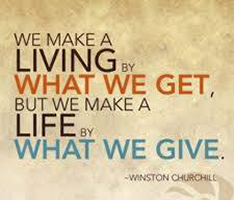Where will your money go in 2015?
Many people intend to have charitable giving be part of their annual spending, but don’t actually plan for it. This may be because families aren’t sure which charities to give to, how much to give, or how to make the gifts.
We know that the fun part is the giving, and the less fun part is the planning; but there are important reasons for making an effort to plan your charitable giving (family budget, values, taxes, understanding which organizations you support). While we intentionally plan the right way to save, invest and budget, charitable giving tends to be done anonymously and without much intension.
“You don’t do kind deeds expecting kindness in return. You don’t do kind deeds because you deem the recipient worthy. You do kind deeds because it’s who you are, and because you understand the powerful difference your gentle hand makes in this dreary world.”
― Richelle E. Goodrich
Three questions to ask yourself when evaluating your charitable giving plan:
1): How much should I give?
There is no one right answer to how much you should give each year, but as with all spending, the amount you give should be planned and intentional. Here are a few ideas to get you started:
- As you think about your annual income, what percentage would you like to give to charity?
- How does that goal compare to what you actually gave in the last several years?
- Work through your family’s income and current expenses. Is that goal percentage realistic given your other commitments?
- Are there tax reasons that influence how much to give in a particular year, e.g. if you know you’ll have a particularly high income year, one idea would be to “pre-fund” several years of charitable gifts in one year. (As described below, Donor Advised Funds can be an excellent tool for this strategy).
Also consider what kind of charitable legacy you want to leave – and if you want others to carry on that legacy.
“It is not what you leave to your children that matters, but what you leave in them.”
― Shannon L. Alder, 300 Questions to Ask Your Parents Before It’s Too Late
2): How do I decide who to give to?
In addition to being intentional about how much to give, you should also be intentional about who you give to.
- Look at who you’ve given to in the past. Do you understand what they do, and does their work match with your values?
- Sit down with your family and create a list of causes or organizations that are working in an area that is meaningful to you.
- Research the charity to determine if they will use your donation efficiently. Here is a great tool to get you started: http://www.charitynavigator.org/
If you don’t have time to take all of these steps, pick an organization that covers many of the causes that you believe in and give one lump sum annually. When charities come calling during the year, feel good about saying that you do all of your charitable giving through one organization.
3): How do I make gifts?
There are several tax advantages to making charitable donations, if the gifts are made properly.
• Give Stock: If you have a non-retirement account that holds highly appreciated securities, work with the organization to give those shares directly to the charity (rather than writing a check to the charity). You receive a charitable deduction for the value of the stock on the day of transfer and avoid paying the capital gains tax that would have been due if you sold the stock (good news). The charity will most likely sell the security upon receipt, but will not owe capital gains tax as they are a qualified charitable organization (double good news).
• Qualified Charitable Distribution (QCD): The last several years Congress has allowed a portion or all of the required minimum distributions (RMD), up to $100,000 after age 70 ½, to be given directly to charity. In contrast, if the RMD was distributed to the taxpayer first, adjusted gross income (AGI) would be increased. Higher AGI impacts other areas of the tax return such as the taxation of Social Security benefits and the threshold levels for medical expense and miscellaneous itemized deductions. By giving the RMD directly to charity, AGI is not increased so tax on other items is potentially decreased. QCD rules ended in 2014, but many think Congress will reinstate this law.
• Donor Advised Fund: If you would like to leave a charitable legacy, or simply control the timing of the charitable tax deduction, consider opening a donor advised fund. Contributions are deductible in the year of the contribution and you have full control over the distributions to charity at a later date. Assets not distributed during your lifetime can be left to a charity or community foundation of your choice or your children can manage the fund and continue your charitable giving.
• Life Insurance Policy: Do you have an old life insurance policy that is no longer needed for your family’s financial security? The policy may be a good candidate to give to a charity.
• Track your giving throughout the year: Always keep documentation for donations to qualified charities and keep with your tax papers.
We know that being charitable giving comes from the heart, but if done properly, you may end up with even more to give!
409
